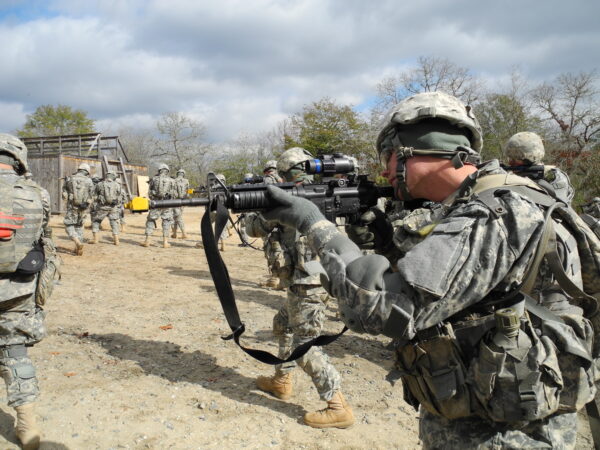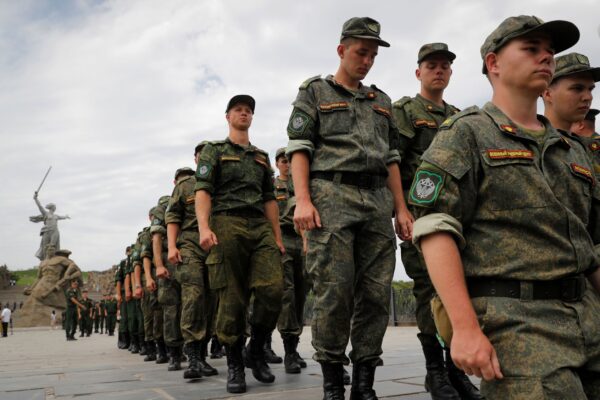Unwilling Conscripts Weak Link in Russian Military
Distressed Patriotic Flag Unisex T-Shirt - Celebrate Comfort and Country $11.29 USD Get it here>>

Commentary
Hundreds of thousands of Russians fleeing military conscription reveal a weak spot in Russia’s armor—an army that refuses to fight.
In late September, Vladimir Putin ordered the conscription of 300,000 young Russian men to fight in the Ukraine war. Since then, Russians have been flooding into Georgia, Kazakhstan, and Mongolia to avoid the draft. The Georgian capital city of Tbilisi had already reported the arrival of 40,000 Russians days after the mobilization. In Ulaanbaatar, Mongolia, Russians are highly visible. According to local sources, some Russian engineers have found work in the mines. Many young Russians are also applying to universities to remain in the country as students. There are also Russians on the streets playing music or begging.
The fact that Ukraine, a country a fraction the size of Russia, can hold out for so long against a Russian invasion has already risen doubts about how powerful the Russian military is. For the United States, this has been a consideration dating back to the end of World War II and the Cold War. Currently, national security analysts consider Russia and China to be the two biggest threats to the United States. As tensions with both nations are rising, comparisons of military strength are being made.
The United States ranks first in global firepower and Russia ranks second. However, Russia has a larger army with between 1 and 2.2 million troops while the United States has 1.4 million. The primary difference between the two armies though is that the U.S. military is composed of professional soldiers who have volunteered and sworn to fight for their country. About 25 percent of Russia’s armed forces are conscripts largely from ethnic minorities, non-Eastern-Orthodox, and the poorest parts of Russia. These soldiers may not wish to kill or die for a government that has kept them as second-class citizens.

Russia is much poorer than the United States in general and with the wealth unequally distributed, the majority of the population has a standard of living on par with a developing country. Ethnic-minority and rural areas, where most of the soldiers are recruited from, are by far the poorest. This inequality could cause resentment for the Moscow elite who control the peasants’ fates.
During Soviet times, drafts were more egalitarian. All males would be conscripted for a finite amount of time to receive basic military training. Afterward, they would periodically be called up, mustered, or activated for additional training or action. After the fall of the Soviet Union, Russia began building a hybrid system that combined conscription and volunteer army service. This system is still in place today. Although the old guard was against having a well-paid professional army, Russia’s experience since the Second World War has been that conscripts were ineffective at fighting a war. In 2015, the number of professional troops holding billets of warrant officers, non-commissioned officers, or soldiers had reached 300,000, the highest up to that point in history (pdf). Within the military, the professional contract units are segregated from conscript units and there is little contact between them.
Russia, like the former Soviet Union, still requires students to undertake patriotic training so that even the incoming conscripts have some basic military and first aid training. Conscripts are sorted by physical, athletic, and linguistic ability and then assigned to airborne, signal, or other appropriate jobs. In 2013, Russia also formed a science unit in which highly educated or intelligent recruits work in areas of technology and research. This has implications for U.S. cybersecurity.

Some of these units fighting in Ukraine today are made up of about 50 percent conscripts. In general, the mass conscription of troops for the Ukraine war is meeting resistance and protests. Normally, Russia would recruit from the rural areas, but the rural population is increasingly non-Russian in ethnicity and less likely to agree to fight for Putin. Violent protests broke out in the Muslim-majority republic of Dagestan in opposition to the draft. Over 100 Dagestanis were arrested.
Ethnic and religious minorities are already subjected to repression in Russia. Due to laws favoring the Russian/Slavic ethnic group and those who follow the Eastern Orthodox religion, 136 of the ethnic languages are on the verge of extinction. The unequal distribution of wealth across the country has led to poverty for most Russians in rural areas and areas which are mainly inhabited by ethnic minorities. The areas where conscripts are mainly drawn from are experiencing high rates of unemployment. In 2021, Ingushetia had 30.9 percent unemployment. Joblessness in the Republic of Dagestan was 15.1 percent, 15 percent in Tuva, 14.5 percent in Chechnya, 13.4 percent in North Ossetia–Alania, 12.3 percent in Karachay-Cherkess, and 12 percent in Altai. The rates have not improved this year.
During its forced conscription of soldiers for the Ukraine war, Russia particularly singled out Mongols from Buryatia, as well as other ethnic minorities, to be sent to the front lines. The regions which have suffered the most casualties are the Republics of Dagestan and Buryatia, the Krasnodar Krai, Bashkortostan, and Volgograd Oblast, which are also areas with a disproportionally high percentage of ethnic peoples. By some accounts, as many as 40 percent of the casualties have been non-Slavic.
Views expressed in this article are the opinions of the author and do not necessarily reflect the views of The Epoch Times.





